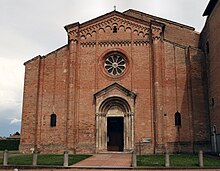
Fontevivo Abbey (Italian : Abbazia di Fontevivo; Latin : Fons Vivus) is a former Cistercian monastery in Fontevivo, Province of Parma, Emilia-Romagna, Italy, about 15 kilometres west of Parma on the Via Emilia towards Fidenza.

Fontevivo Abbey (Italian : Abbazia di Fontevivo; Latin : Fons Vivus) is a former Cistercian monastery in Fontevivo, Province of Parma, Emilia-Romagna, Italy, about 15 kilometres west of Parma on the Via Emilia towards Fidenza.
In May 1142 a colony of twelve Cistercian monks from the abbey of Chiaravalle della Colomba founded a monastery on land given by Bishop Lanfranco of Parma and Delfino, son of Oberto Pallavicino, in a spot named Fontevivo ("living spring") after the spring that rose there on the left bank of the Parola brook.
After clearing and improving the site, which was a well-watered one between the Taro and the Stirone rivers, the Cistercians turned to construction and had soon built a large abbey church and the accompanying conventual buildings. In 1144 Pope Lucius II confirmed to Viviano, the first abbot, possession of the abbey's lands and put it under the immediate protection of the Holy See.
The newly settled abbey, as a daughter house of Chiaravalle della Colomba, belonged to the filiation of Clairvaux. As early as 1146 Fontevivo was made the mother house of the abbey of San Giusto in Tuscania. (Mirteto Abbey near Pisa may also have been made a daughter house of Fontevivo in 1227).
In 1245 the abbey was occupied and sacked by the army of the Emperor Frederick II during the siege of Parma. By the 15th century its decline was unstoppable, accelerated by the introduction of commendatory abbots early in the century and by the damage caused by the troops of Ludovico il Moro in 1483. In 1497 Fontevivo entered the Italian Cistercian Congregation, but by this time was already fatally compromised.
In 1518 Pope Leo X united it with San Paolo fuori le Mura in Rome, thus transferring it to the Benedictine Cassinese Congregation. [1] It was at this point that the great majority of the abbey's archives was lost. The property and temporal jurisdiction of the abbey was acquired by Ranuccio I Farnese, Duke of Parma, in 1605. In 1614 the Cassinese transferred the spiritualities to the Benedictines of the abbey of Saint John the Evangelist in Parma, which was independent of the bishops of Parma, as Fontevivo had been as a territorial abbey. Only when it was finally merged into the Diocese of Parma in 1893, when the Benedictines gave it up, did the bishops gain authority over it, and have since used the honorary title of "Abbot of Fontevivo".

The only surviving building of the abbey is the former abbey church, now the parish church of Fontevivo, dedicated to Saint Bernard. The Villeggiatura del Collegio dei Nobili, an accommodation block now converted to flats, was constructed on the site of the conventual buildings in 1733 for the use of the Collegio, based in Parma, during the holidays. The arcaded courtyard preserves the outline of the cloister.
The abbey church, in the shape of a Latin cross, has a modest transept with two side chapels in each wing (those in the north wing are walled up), and a square apse. The nave has a central aisle and two side aisles, each of six bays. Instead of groin vaulting as originally intended, the church has rib vaulting. The construction of the vault over the crossing is unusual.
The brick west front, a three-part staggered gable front with a rose window containing ten radiating marble columns, was rebuilt by the monks in the 15th century and has since been much worked over. A Lombard band runs around much of the church.
A niche in one of the aisles holds a 12th-century Madonna and Child, a small polychrome stone statue recently attributed to Benedetto Antelami.
In the north transept is the red marble tombstone, dated 1301, of the Marchese Guido Pallavicini, a knight templar and a benefactor of the abbey. At the end of the north aisle is the Classical tomb in bronze and marble of the last Duke of Parma of the pre-Napoleonic period, Ferdinand of Bourbon (died 1802), by the Spanish architect Francesco Martin Lopez.

An abbey is a type of monastery used by members of a religious order under the governance of an abbot or abbess. Abbeys provide a complex of buildings and land for religious activities, work, and housing of Christian monks and nuns.

The Benedictines, officially the Order of Saint Benedict, are a mainly contemplative monastic order of the Catholic Church for men and for women who follow the Rule of Saint Benedict. Initiated in 529 they are the oldest of all the religious orders in the Latin Church. The male religious are also sometimes called the Black Monks, especially in English speaking countries, after the colour of their habits. Not all Benedictines wear black, however, with some like the Olivetans wearing white. They were founded by Benedict of Nursia, a 6th-century Italian monk who laid the foundations of Benedictine monasticism through the formulation of his Rule. Benedict's sister, Scholastica, possibly his twin, also became a religious from an early age, but chose to live as a hermit. They retained a close relationship until her death.
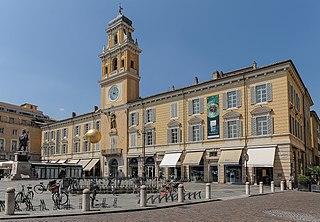
Parma is a city in the northern Italian region of Emilia-Romagna known for its architecture, music, art, prosciutto (ham), cheese and surrounding countryside. With a population of 198,292 inhabitants, Parma is the second most populous city in Emilia-Romagna after Bologna, the region's capital. The city is home to the University of Parma, one of the oldest universities in the world. Parma is divided into two parts by the stream of the same name. The district on the west side of the river is Oltretorrente. Parma's Etruscan name was adapted by Romans to describe the round shield called Parma.

A priory is a monastery of men or women under religious vows that is headed by a prior or prioress. They were created by the Catholic Church. Priories may be monastic houses of monks or nuns. Houses of canons & canonesses regular also use this term, the alternative being "canonry". Mendicant houses, of friars, nuns, or tertiary sisters also exclusively use this term.

Ely Cathedral, formally the Cathedral Church of the Holy and Undivided Trinity, is an Anglican cathedral in the city of Ely, Cambridgeshire, England.

The Benedictine Confederation of the Order of Saint Benedict is the international governing body of the Order of Saint Benedict.

Farfa Abbey is a territorial abbey in northern Lazio, central Italy. In the Middle Ages, it was one of the richest and most famous abbeys in Italy. It belongs to the Benedictine Order and is located about 60 km (37 mi) from Rome, in the comune (municipality) of Fara Sabina, of which it is also a frazione (hamlet).
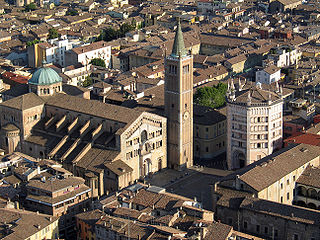
Parma Cathedral is a Roman Catholic cathedral in Parma, Emilia-Romagna (Italy), dedicated to the Assumption of the Blessed Virgin Mary. It is the episcopal seat of the Diocese of Parma. It is an important Italian Romanesque cathedral: the dome, in particular, is decorated by a highly influential illusionistic fresco by Renaissance painter Antonio da Correggio.

Bobbio Abbey is a monastery founded by Irish Saint Columbanus in 614, around which later grew up the town of Bobbio, in the province of Piacenza, Emilia-Romagna, Italy. It is dedicated to Saint Columbanus. It was famous as a centre of resistance to Arianism and as one of the greatest libraries in the Middle Ages. The abbey was dissolved under the French administration in 1803, although many of the buildings remain in other uses.

Alseno is a comune (municipality) in the Province of Piacenza in the Italian region Emilia-Romagna, located about 120 kilometres (75 mi) northwest of Bologna and about 25 kilometres (16 mi) southeast of Piacenza.

Fontevivo is a comune (municipality) in the Province of Parma in the Italian region Emilia-Romagna, located about 100 kilometres (62 mi) northwest of Bologna and about 14 kilometres (9 mi) northwest of Parma. As of 9 October 2011, Fontevivo had a population of 5,428 and an area of 25.9 square kilometres (10.0 sq mi).
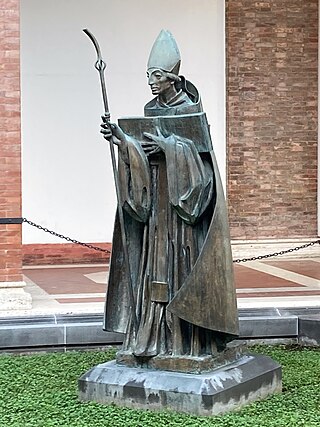
Sant'Anselmo all'Aventino is a complex located on the Piazza Cavalieri di Malta Square on the Aventine Hill in Rome's Ripa rione and overseen by the Benedictine Confederation and the Abbot Primate. The Sant'Anselmo complex, also known as the "Primatial Abbey of Sant'Anselmo" because it is the residence of the Abbot Primate, consists of: an ecclesiastical residential college known as the "College of Sant'Anselmo" ; a university known as the "Pontifical Athenaeum of Saint Anselm" ; the "Church of Sant'Anselmo" ; and the curial headquarters of the "Benedictine Confederation" and Abbot Primate. The complex and associated institutions are named in honor of the Benedictine monk Saint Anselm of Canterbury.
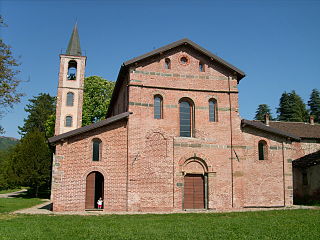
Tiglieto Abbey is a monastery in Tiglieto, Liguria, northern Italy. It was the first Cistercian abbey to be founded in Italy, and also the first outside France.

The Abbey of Santa Maria di Rovegnano is a Cistercian monastic complex in the comune of Milan, Lombardy, northern Italy. The borgo that has developed round the abbey was once an independent commune called Chiaravalle Milanese, now included in Milan and referred to as the Chiaravalle district.
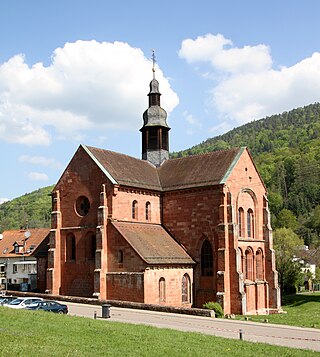
Eusserthal Abbey was a Cistercian abbey in Eusserthal near Annweiler am Trifels in the Rhineland-Palatinate, Germany. All that now remains of it is the front portion of the abbey church, which is now used as a parish church.
The Abbey of San Giusto is a former Cistercian monastery located in the valley of the river Marta approximately 4 km south of Tuscania, Province of Viterbo, Italy.

The Abbey of Chiaravalle della Colomba is a 12th-century Cistercian monastic complex near the town of Alseno, in the Province of Piacenza, Region of Emilia-Romagna, Italy.

The College of Sant'Anselmo is an international Benedictine college founded by Pope Leo XIII in 1887 and located in Rome, Italy. Situated on the Aventine Hill, it is one of four Benedictine institutions that occupy the complex known as "Sant'Anselmo all'Aventino" which serves as the Primatial Abbey of the Benedictine Confederation. As an ecclesiastical residential college in the Roman College tradition, it serves as both a house of formation for Benedictines, but also as a residence for over one hundred monks from around forty countries, religious, diocesan priests, and lay people. It offers a monastic environment for those who study at the onsite Pontifical Athenaeum of Saint Anselm or at other Roman pontifical universities.
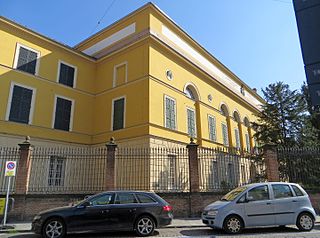
The Convitto Nazionale Maria Luigia, once known as the Collegio Ducale Maria Luigia, is a state school located on Borgo Lalatta 14 within the grounds of the Palazzo Imperiale dell'Arena in Parma, region of Emilia-Romagna, Italy.
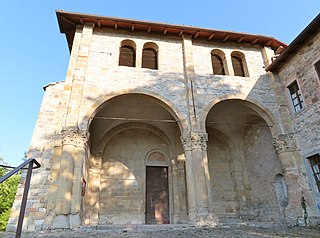
The Abbey of San Basilide (Italian: Abbazia di San Basilide, also known as Badia Cavana, is a former Vallombrosan monastery and church located in the neighborhood of San Michele Cavana of the town of Lesignano de' Bagni, Province of Parma, region of Emilia-Romagna, Italy.